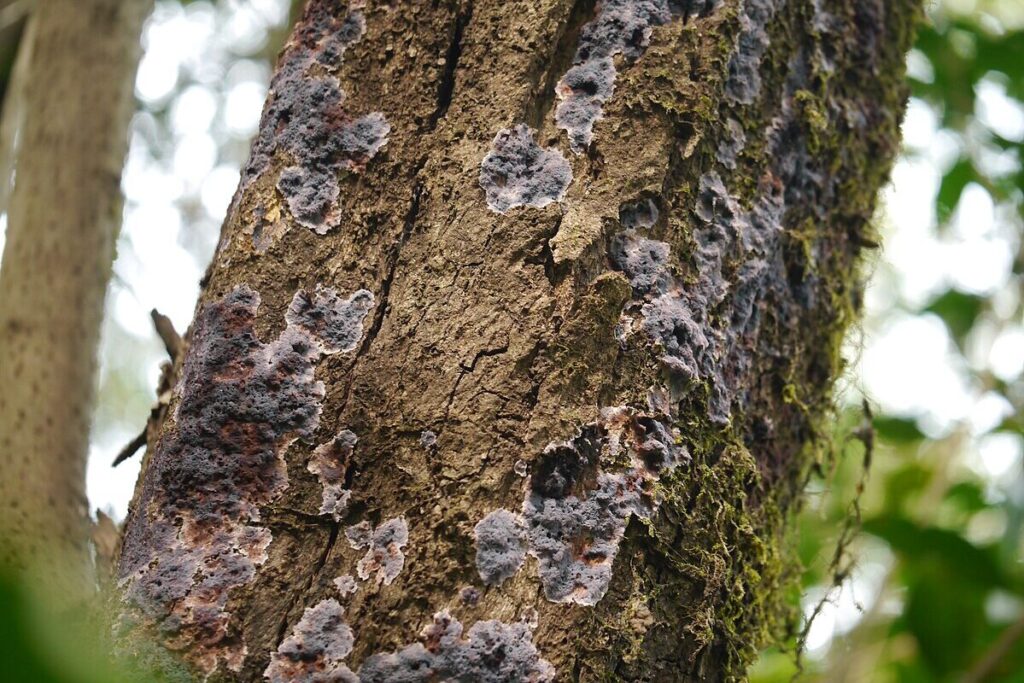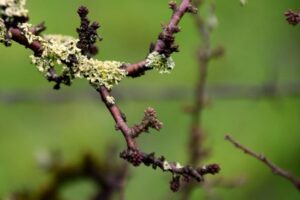What Can Lichens Tell Us About Atmospheric Pollution?
Feb 5, 2024 | Pratirodh Bureau
Lichen on a tree bark. Lichens are known for their resilience in the face of pollution, a trait that has positioned them as biomonitors and bioindicators (Photo by Dinesh Valke/Wikimedia Commons)
- Lichens are composite organisms born out of a mutualistic alliance between a fungus and a photosynthetic partner, typically algae or cyanobacteria.
- Found in diverse environments, lichens rely directly on the atmosphere for nutrients, allowing pollutants to directly enter them without any filtration.
- Lichens are bioindicators and biomonitors providing invaluable clues about the quality and quantity of pollution in the environment.
At the turn of the millennium, Kodaikanal, a quaint South Indian hill town in Tamil Nadu, found itself engulfed in angst as protests erupted across various parts of the town. The cause of this discontent was a large thermometer manufacturing factory situated near Kodaikanal lake. This facility, owned by the corporate giant Hindustan Unilever, was discovered to be polluting the soil, water and air through the indiscriminate disposal of factory waste containing mercury. The factory was exposed for its illegal practices and subsequently faced penalties.
The most compelling scientific evidence against mercury poisoning surfaced through the examination of a plant-like substance found around the factory — lichens. In the 2023 book Heavy Metal, narrating the story of Kodaikanal’s mercury poisoning, it is documented that a prominent scientist at the Department of Atomic Energy in Hyderabad, situated over 1,000 km away from Kodaikanal, detected something amiss in the flavouring agent, lichen, in his biryani. Upon testing, he discovered traces of mercury and traced the source of these lichens back to Kodaikanal. Further laboratory tests on lichens from around the factory confirmed his worst fear — mercury traces in the hill town’s otherwise pristine air.
What Are Lichens?
Lichens are captivating organisms in nature, often found plastered on tree barks and rocks in wet or moist habitats. The rocky mountains of the Himalayas would not be as attractive in the absence of the greens, yellows, greys and silver-greys of lichens attached to the tree barks and imposing boulders and rocks. It could be flower-like or crusty or may even appear as colours splashed accidentally over a surface.

According to the British Lichen Society, lichens are composite organisms resulting from a mutualistic alliance between a fungus and a photosynthetic partner known as photobiont, typically algae or cyanobacteria. The fungus forms a protective outer cover for the enclosed algae. While the fungus absorbs water and nutrients from the air, the photosynthetic partner generates organic compounds through photosynthesis. This harmonious partnership enables lichens to flourish in diverse environments, ranging from rocky mountain sides to harsh Arctic tundras. Unlike plants, lichens lack cuticles for protection or roots to draw nutrients from deep within the soil. They rely directly on the atmosphere for nutrients, making them susceptible to the entry of pollutants into their thallus without filtration.
Scientist Sanjeeva Nayaka, who heads the lichenology and algology laboratory at the CSIR-National Botanical Research Institute, Lucknow, highlights that lichens exhibit sensitivity to atmospheric changes, with increased responsiveness in moist conditions, particularly during the early mornings or late evenings when temperatures drop. “As the pollution load in the air rises, the lichen cell breaks, leading to the bleaching of the organism and its demise,” he explains. Nevertheless, Nayaka notes the existence of tolerant lichens capable of surviving pollution.
India boasts a rich diversity of lichens, with approximately 3000 species, according to Nayaka. Studies have revealed their medical properties, acting as antibacterial, anti-inflammatory and anti-cancer agents, to name a few.
One specific lichen, Parmotrema perlatum, commonly known as black stone flower and referred to by various names in regional Indian languages such as Pathhar Ke Phool in Hindi, Kalpasi in Tamil, Kallu Hoovu in Kannada, and so on, is frequently collected by tribals from within the forests. They employ it for various purposes, including the preparation of herbal medicines and as a flavour enhancer in certain Indian dishes, such as biryani.
Why Are Lichens Considered Good Biomonitors?
Lichens are known for their resilience in the face of pollution, a trait that has positioned them as biomonitors and bioindicators. Their sensitivity to environmental shifts makes them valuable instruments for monitoring air quality and ecological health.
Scientists utilise a variety of living and non-living organisms to assess environmental quality and pollution levels. Bioindicators are organisms that furnish information about the quality of the environmental parameters studied, while biomonitors provide clues on the quantitative aspects of the environmental quality. For instance, fish serve as excellent bioindicators for evaluating the ecological integrity of aquatic systems. A 2003 study states that no other aquatic organism is as well-suited to assess the severity of toxic impacts. The tissues, blood, and structural anomalies of fish offer crucial insights into the health of aquatic systems.
It is important to note that all biomonitors are bioindicators, but the reverse is not necessarily true. Fish can function as effective bioindicators but not as biomonitors, as they cannot provide information about the quantity of pollutants in the environment being studied. Conversely, organisms such as lichens and mosses serve as excellent biomonitors, as they not only convey information about the quality of the environment but can also be examined to understand the pollution load. In Nayaka’s studies of lichens, sulphur dioxide and heavy metals have been predominantly identified as pollutants absorbed by these organisms.
How Are Lichens Studied In The Scientific World?
Different lichen species react differently to different pollutants. Scientists, however, evaluate environmental damage to lichens using certain parameters, such as photosynthesis, chlorophyll content and degradation; decrease of ATP (adenosine triphosphate, the energy carrying molecule in cells); ethylene production and more. Furthermore, laboratory exposure to sulphur dioxide has been found to cause relevant membrane damage to lichen cells. Studies have shown a positive correlation between the sulphur content of lichens and sulphur dioxide present in the atmosphere. Furthermore, researchers have reported altered concentration of chlorophyll in lichens when exposed to vehicular pollution as well as urban emissions.
Scientists, often in unforeseen ways, leverage lichens to examine atmospheric conditions and even estimate the age of surfaces they colonise. The earlier-mentioned Kodaikanal case underscores the role of lichens in uncovering environmental pollution.
A consequence of the 1986 Chernobyl explosion in Ukraine was the prohibition of reindeer meat in certain European countries, such as central Sweden and Norway. This decision was prompted by the discovery of high radiocaesium levels in the bodies of reindeer, adversely impacting the meat industry and the traditional livelihood of Sami herders in Norway. One hypothesis is that reindeer that feed on lichens, ingested radiocaesium absorbed by lichens, according to Nayaka.
In a changing climate scenario, lichens have been studied to understand how they are adapting to global warming. A 2022 study points to the probability of lichens not being able to keep up with climate change as they likely would need around one million years to cope with a temperature increase of one degree Celsius.
Despite the presence of diverse lichens in India, the organism is often studied only for academic purposes. On the other hand, lichen studies are included in policy documents to study air pollution in certain European countries, shares Nayaka. “There is a good diversity of lichens in India which remain unexplored. We need to collect, identify and create some sort of inventory for better use of lichens in scientific research,” he says on the current status of lichen studies in the country.
(Published under Creative Commons from Mongabay-India. Read the original article here)
